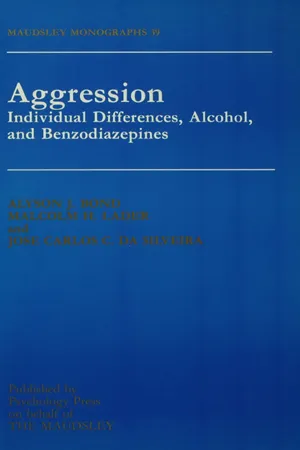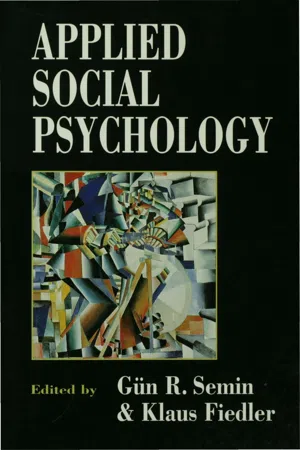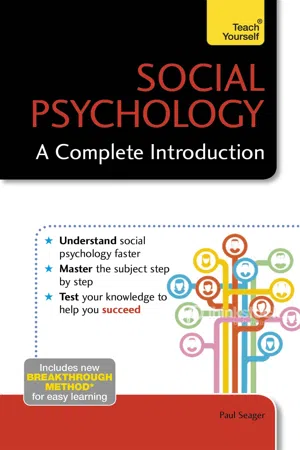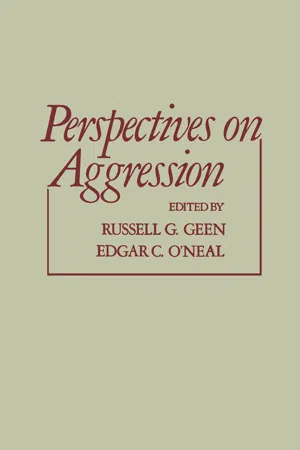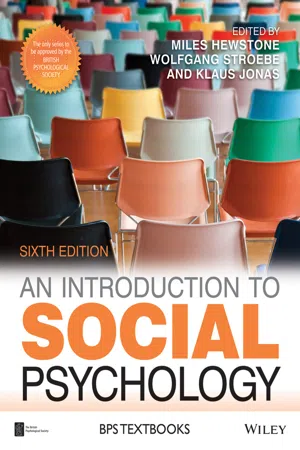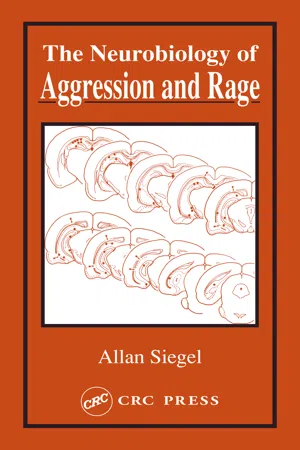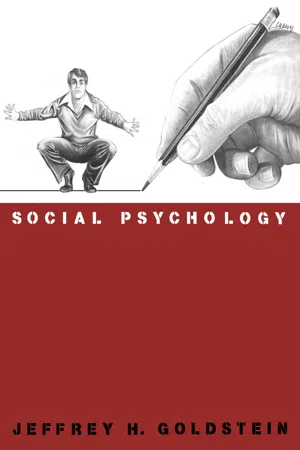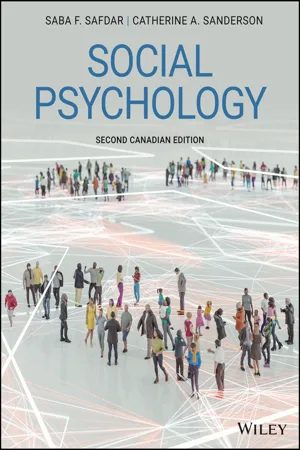Psychology
Aggression
Aggression refers to behavior intended to cause harm or injury to another person or object. In psychology, it is studied in the context of understanding the underlying causes, triggers, and consequences of aggressive behavior. This can include exploring biological, psychological, and social factors that contribute to aggression in individuals and groups.
Written by Perlego with AI-assistance
Related key terms
1 of 5
11 Key excerpts on "Aggression"
- eBook - ePub
Aggression
Individual Differences, Alcohol And Benzodiazepines
- Alyson Bond, Malcolm Lader, Jose da Silveira(Authors)
- 2013(Publication Date)
- Psychology Press(Publisher)
CHAPTER ONEThe psychology of Aggression
In this chapter, definitions and theories of aggressive behaviour are discussed. Several factors are important in aggressive behaviour and these are discussed under three broad headings: interpersonal factors, external factors, and individual differences.TERMINOLOGY
Aggression is a word that in ordinary language encompasses a wide range of behaviours. However, these sometimes diverse behaviours seem to have a common thread and the aim of a psychological definition is to explain this. There have been many definitions of Aggression. For example, Harre and Lamb (1983, p.13) catalogued more than 250. These various definitions seem to share the idea that Aggression involves inflicting harm or damage but beyond this, there are a number of differences. For example, does the damage have to be inflicted on a living creature or does damage to objects or property also count as Aggression? Does the damage have to be physical as argued by Zillman (1978) or does psychological harm such as saying something hurtful or damaging someone's reputation also constitute an aggressive act? Given that these distinctions may be important, one solution is to define Aggression broadly but then describe different types of Aggression. This approach has been taken by Buss (1961) who said Aggression could be physical or verbal, active or passive, direct or indirect. Combining these factors yields eight types of Aggression altogether.Another issue, perhaps less easily resolved, concerns whether the damage or harm must be inflicted intentionally for the act to be considered aggressive. On the one hand it seems desirable to exclude inflicting harm accidentally, e.g. accidentally hitting someone with an object or saying something tactless without thinking. On the other hand, intentions cannot be observed and it may cause problems to use a definition that rests on unobservable behaviour. This was the view of Buss (1961) and Bandura (1973) whose definitions ignore the intentions that may lie behind the "response that delivers noxious stimuli to another organism". Despite these difficulties, many authors have included intention in their definitions of Aggression. For example, Dollard, Doob, Miller, Mowrer, and Sears (1939) defined Aggression as "an act whose goal-response is injury to an organism". Berkowitz (1974) also argues that intention is crucial. This was taken up by Geen (1976) whose working definition can be summarised in three points: (1) "Aggression consists of the delivery of noxious stimuli by one organism to another"; (2) "The stimuli are delivered by the former with the intent to harm the latter"; (3) "The one delivering the stimuli expects that the probability of the stimuli reaching the source is greater than zero". Note that this definition does not specify any particular emotional state, such as anger, or any particular attitude towards the victim, such as dislike or hostility. It does specify intention to harm but this should not be taken to exclude other intentions or motives. - eBook - PDF
- Gün R Semin, Klaus Fiedler, Gün R Semin, Klaus Fiedler(Authors)
- 1996(Publication Date)
- SAGE Publications Ltd(Publisher)
The final section will be devoted to strategies and proposals for reducing Aggression and violence, ranging from individual-centred psychological intervention to long-term measures implemented at the sociopolitical level. Aggression and violence: definition and nneasurennent While 'Aggression ' is an established term not just among psychologists but also in the vocabulary of ordinary language, defin ing its exact meaning is by no means a straightforward task. As Krebs and Miller (1985) point out, definitions can focus on different aspects, varying in their implications for the identi-fication and classification of behaviours as 'aggressive ': they may concentrate on observable behaviours as opposed to intentions and motives, on verbal as opposed to physical Aggression expressed in direct or indirect forms, on the psychological vs. physical effects of Aggression, either immediate or long term. There appears to be general consensus nowadays that a purely behavioural definition of Aggression, as 'a response that delivers noxious stimuli to another organism' (Buss, 1961, p. 1), falls short of capturing the psychological signifi-cance of the concept. Additional aspects have to be included in the definition to eliminate behaviours not commonly thought of as aggressive: -the intention to cause harm to a person or damage an object (e.g . to exclude the driver killing a pedestrian who crosses the road without looking); -the expectancy that the behaviour will result in harm to the target (e.g. to exclude the helper who aggravates the injuries of an accident victim by taking the wrong actions through lack of competence); Aggression and Violence in Society 345 -the willingness on behalf of the target person to avoid the harmful treatment (e.g. to exclude the doctor who performs an operation on the patient's request). The actual consequences of an aggressive action do not feature in the definition of Aggression along these lines. - Paul Seager(Author)
- 2014(Publication Date)
- Teach Yourself(Publisher)
It is difficult to arrive at a comprehensive definition of Aggression in all its various forms. For example, it would need to include verbal and physical behaviour, direct action leading to Aggression and a failure to act which results in Aggression, direct and indirect Aggression, overt and covert Aggression, Aggression that is unprovoked and that which is retaliative, physical Aggression and psychological Aggression, and so on and so forth. On top of that, there are also cross-cultural issues to consider, such that what might be seen as acceptable behaviour in one culture may be seen as taboo in another: for example, a faction of Australian aborigines see violence as ordinary and necessary, but Western cultures would view it as anti-social and probably illegal (see Spotlight below).Spotlight: Defining AggressionAn early attempt to define Aggression comes from Baron (1977) who states that it is ‘any form of behaviour directed toward the goal of harming or injuring another living being who is motivated to avoid such treatment’.It is generally accepted that there are two type of Aggression:A good definition should probably incorporate intent, the expectancy that an action will cause harm, that avoidance of Aggression from the victim’s point of view is preferable, and that any such behaviour is a violation of social norms.1 Hostile Aggression: In this form, Aggression is usually provoked by pain or upset, and is very emotional. Often it is performed as an end in itself. It might be illustrated by a boyfriend who punches his girlfriend after she yells at him.2 Instrumental Aggression:- eBook - PDF
Motivation and Emotion
Evolutionary, Physiological, Cognitive, and Social Influences
- David C. Edwards(Author)
- 1998(Publication Date)
- SAGE Publications, Inc(Publisher)
To others, Aggression means attacking and hostile ac-tions, like the prototypical out-of-control an-gry person intending to inflict harm. The intention and the result is to harm another per-son and, in extremity, do violence. Still an-other view is that Aggression labels a certain style of act. Such aggressive styles are nearly synonymous with high motivation. An execu-tive is said to have an aggressive management style. We describe basketball players as ag-gressive in shooting. These and similar mean-ings imply that one person is acting to gain an advantage or achieve superiority over others. At least some of the differences in defin-ing Aggression seem to come from whether Aggression is seen as a force producing harmful or violent acts or as a result of con-ditions and events that have occurred. An ex-treme biological theorist may be more comfortable with Aggression as a force or function that is primed and often engaged. An extreme social context position accepts some kinds of acts from social encounters as being usefully labeled aggressive. Still another po-sition may propose an intermediary state of anger as the key to eliciting aggressive acts in a social encounter. These, of course, do not exhaust the possibilities. Some aggressive acts are socially ad-mired, whereas others are generally con-demned. Evaluation of action fragments depends upon social aspects of the situation and of the evaluator. An act is seen as aggres-sive if the victims are not willingly partici-Anger and Aggression |§] 131 pating or deserving of punishment. Thus, some theorists insert the idea of the aggres-sion target being an unwilling participant. The winner in a boxing match is not con-demned by sports enthusiasts as an aggressor, but exactly the same actions against a passer-by in the street would be thought a heinous mugging. People of more genteel thought might see both events as aggressive violence. - eBook - ePub
- Miles Hewstone, Wolfgang Stroebe, Miles Hewstone, Wolfgang Stroebe(Authors)
- 2021(Publication Date)
- BPS Blackwell(Publisher)
Compared to the wealth of research on the causes and precipitating factors of aggressive behaviour, evidence on how to reduce it is limited. Contrary to popular wisdom, catharsis, i.e., acting out aggressive impulses in a symbolic way, is counterproductive in reducing Aggression. It leads to an increase rather than a decrease in aggressive responses. Punishment may be a potentially effective strategy for reducing Aggression, but only if it is imposed swiftly. However, a disadvantage is that punishment also involves inflicting harm on the target person, making Aggression appear as an acceptable way of resolving conflicts. Eliciting prosocial behaviour or eliciting affective states that are incompatible with anger may be promising methods of situational Aggression control by influencing affective and cognitive antecedents of aggressive behaviour.CHAPTER SUMMARY
This chapter has provided an overview of the main theories, methods and findings of social psychological research on Aggression and looked at forms of Aggression that are part and parcel of everyday life. The main conclusions of the chapter can be summarized as follows:- What is Aggression and why does it occur? Aggressive behaviour is defined as behaviour carried out with the intention of harming another person. It can be a means to an end (instrumental Aggression) or an expression of angry affect (affective or hostile Aggression).
- What methods do social psychologists use to study Aggression? Methods for studying aggressive behaviour include laboratory experiments, reports of aggressive behaviour from actors and observers, and the analysis of archival records.
- What are the main theoretical approaches used in social psychological research on Aggression?
- eBook - PDF
- Russell G. Geen, Edgar C. O'Neal, Russell G. Geen, Edgar C. O'Neal(Authors)
- 2013(Publication Date)
- Academic Press(Publisher)
The basis of categorization may be stimulus situations (Moyer, 1971), mode of delivery (Buss, 1971), harm intent (Weiss, 1969), or coercive power (Tedeschi, Smith, & Brown, 1974) to name just a few. Each of these approaches has advantages, yet none foreshadows a general consensus of what constitutes Aggression. Finally, any conclu-sions we may draw about the definitions of Aggression currently being offered will be valuable only to the extent that they offer an externally valid explanation of the nature of Aggression beyond the laboratory. Because Aggression is a social problem, any definition of Aggression will have value implications, if not to the researcher then at least to much of his audience. However, the variety of possible behaviors which we may label aggressive and the limitations of investigating many of these in laboratory situations forces us to make careful distinctions between aggressive responses as a dependent measure in the laboratory and Aggression as a social problem. For much of the remainder of this chapter, I will use the rather unorthodox approach of allowing as a definition of Aggression the response measure as operationalized by the researcher, postponing discussion of a unitary definition until later on. An Aggression Paradigm Perhaps the most widely used research paradigm in Aggression re-search is some variation of those used by Buss (1961) and Berkowitz (1965). This paradigm places the subject in a position of administering noxious stimulation (typically electric shock) to another subject under the guise of a learning or evaluation experiment in which errors are punished or negative evaluations administered by the delivery of the noxious stimulation. In actuality, the learner in the experiment (or the person being evaluated) is a confederate of the experimenter and receives no noxious stimuli. The measure of Aggression is the number, intensity, duration, or latency of shock that the subject thinks he is administering. - eBook - ePub
- Miles Hewstone, Wolfgang Stroebe, Klaus Jonas, Miles Hewstone, Wolfgang Stroebe, Klaus Jonas(Authors)
- 2016(Publication Date)
- BPS Blackwell(Publisher)
The research reviewed in this section shows that aggressive behaviour varies both as a function of person variables and as a function of situational context. Stable individual differences in the propensity to act aggressively (trait aggressiveness) and to interpret others’ actions as an expression of hostile intent (hostile attribution bias) predict differences in the ease with which aggressive responses are triggered in a particular situation. Research has also identified gender differences, with men showing more physical Aggression than do women. So far, the evidence is less clear-cut for indirect Aggression, such as spreading rumours. Among the situational variables affecting the likelihood of aggressive behaviour, research has consistently shown that alcohol consumption, high temperature and exposure to media violence lower the threshold for aggressive behaviour. In the case of media violence, longitudinal studies have demonstrated that negative effects can be found over extended periods of time.Aggression AS A SOCIAL PROBLEM
What do we know about the prevalence and the risk factors of intimate partner violence, sexual Aggression, bullying and violence between groups?
The theoretical and empirical contributions discussed so far identified critical input variables as well as cognitive, affective and arousal processes that explain the occurrence of aggressive behaviour. In this section we will look at specific forms of aggressive behaviour between individuals and between groups and discuss how the theories and findings examined earlier can contribute to a better understanding of these social problems.Intimate partner violence
‘Intimate partner violence’ is defined as the perpetration or threat of an act of physical violence, by one partner on the other, in the context of a dating/marital relationship. It is a serious problem across the world, even though the prevalence rates vary enormously, not only between, but also within countries (see reviews of the international evidence by Krahé, Bieneck, & Möller, 2005; Krug, Dahlberg, Mercy, Zwi, & Lozano, 2002). One of the most contentious issues in this field of research refers to the question of whether men and women are involved in intimate partner violence to the same or a different degree. Two main data sources are available to address the scale of intimate partner violence and the question of men’s and women’s involvement as perpetrators: (a) official crime statistics and crime victimization surveys using representative samples; and (b) research collecting self-reports of perpetration of, or victimization by, relationship Aggression, using the Conflict Tactics Scales (CTS) - eBook - PDF
- Allan Siegel(Author)
- 2004(Publication Date)
- CRC Press(Publisher)
What Is Aggression? 3 irritating. The response can be directed to a wide variety of subjects, and is generally not associated with escape or flight behavior. A related form of Aggression is found in cats (Figure 1.1), and is referred to as “affective defense” (also called “defensive rage”). Considerable research has been conducted with this model of Aggression in cats, and is considered in detail in subsequent chapters. 5. Sex-related Aggression . This type of Aggression is more commonly observed in humans and to a lesser extent in animals. In humans, this type of Aggression may manifest itself in a variety of ways, some of which are strange or bizarre. Here, sexual arousal is frequently associated with increased levels of hostility or hostile fantasies. In animals, components of aggressive behavior are sometimes associated with sexual acts. In such instances, the aggressive and sexual aspects appear as components of the same behavioral act, thus creating difficulties in classifying these behav-iors. Overall, few studies involving this form of Aggression have been conducted, especially in animals. 6. Predatory Aggression . This form of Aggression is basically unrelated to the other forms of Aggression described above and can be distinguished from them because (1) it is specifically triggered by the presence of a prey object within the visual field of the predator, and (2) a predator will display predation regardless of the environment in which it is placed. Predatory attack behavior has been studied most extensively in cats, where this response can be elicited by electrical stimulation of the lateral FIGURE 1.1 Defensive rage behavior in the cat. This response is elicited by electrical stimulation of the medial hypothalamus of the cat. The response induced closely mimics that seen under natural conditions when the cat is threatened by another species. - eBook - PDF
On Aggression and Violence
An Analytic Perspective
- Richard Mizen, Mark Morris(Authors)
- 2006(Publication Date)
- Bloomsbury Academic(Publisher)
Towards a Theory of Aggression and Violence The Concept of Aggression In the previous chapters we have considered some of the main developments in analytic concepts of Aggression and violence. In addition to these developments, with their roots in differing ana-lytic schools and traditions, we have noted that confusion arises because of the ways that they have been conflated with each other and with related concepts. Partly this is a consequence of the enormous complexity of the subject matter but there has also been a tendency to try to false fit earlier metapsychological con-cepts with later ideas to preserve the ‘integrity’ of particular the-ories. This has often flown in the face of new developments in alternative analytic and other non-analytic but relevant disci-plines and one result of this has been the politicized polarization of the debate along the lines of particular theories or theorists. As we have seen, this has been particularly the case in relation to the genesis of Aggression where it has been allocated a totemic role in relation to the location of the origins of Aggression. To try to strip away at least a little of the confusion without adding too much of our own, we would like to reconsider the concepts of Aggression and violence separately in an attempt to distinguish them one from the other and also to establish the relation between them. As we will come to see in subsequent chapters, this has important implications for clinical practice. The word and concept ‘Aggression’ makes most sense when it is used in a way that implies a broad-based phenomenon, the set, as it were, of which ‘violence’ along with other phenomena such as ‘brutality’, ‘destructiveness’ and ‘sadism’ are sub-sets even where these terms are used interchangeably. As we have noted different words are often used to mean the same thing; in both Freud and Klein, for example, the words 52 4 ‘Aggression’, ‘destructiveness’ and ‘sadism’ are frequently used interchangeably. - eBook - PDF
- Jeffrey H Goldstein(Author)
- 2013(Publication Date)
- Academic Press(Publisher)
The United States had originally backed this proposal. There then followed no less than ten tension-reducing steps by both sides. From June to mid-October, each side responded to conciliatory gestures by the other. By late October, there was a marked slowdown in American initiatives. Etzioni notes several reasons for this: the administration felt that the psychological mood of optimism and rising expectations about Soviet-American relations were running too high; allies, particularly West Germany, objected bitterly; and in the pre-election year, the administration did not want to seem overly accommodating toward the Russians. This analysis of complex historical events after the fact is less than the ideal test of the theory. However, some laboratory simulations also provide support for the model (e.g., Pilisuk & Skolnik, 1968). Human Aggression is behavior whose intent is the injury of another person. Three common arguments for the belief that Aggression is an instinct in humans—from biology, physiology, and psychoanalytic theory—lead us to conclude that Aggression in humans is most likely a learned set of behaviors. In laboratory research on Aggression, electric shock is often used as the dependent measure, and it is less than ideal as a measure of human Aggression. Studies of children's Aggression tend to observe Aggression during play. Frustration-Aggression theory has been modified several times since its inception in 1939, first by some of its original authors, later by Berkowitz, and then by Zillmann's notions of arousal and attri-bution. Berkowitz believes that frustration as well as anger may lead to Aggression only when appropriate environmental cues are present. Such cues are learned in humans and may include appropriate targets, places, and means of aggressing. The notion of an aggressive cue is analogous to the concept of a releaser cue in biology. - eBook - PDF
- Saba Safdar, Catherine A. Sanderson(Authors)
- 2021(Publication Date)
- Wiley(Publisher)
cognitive-neoassociation theory – a theory that describes Aggression as caused by experiencing negative affect of any kind, which in turn evokes Aggression-related thoughts, memories, feelings, and ideas 345 How Do Social Psychological Factors Influence Aggression? Various environmental factors, including ozone levels, cigarette smoke, wind speed, and humid- ity, are associated with rates of Aggression, as evidenced by calls to police for assistance during assaults (Rotton & Frey, 1985; Zillman, Baron, & Tamborini, 1981). Feeling personally rejected or ostracized can also lead to more aggressive behaviour (Li, Zhao, & Yu, 2019; Twenge, Baumeister, Tice, & Stucke, 2001). CUES TO Aggression. According to the cognitive-neoassociation theory, another factor that can trigger aggressive behaviour is the mere presence of an object associated with aggres- sion (Bushman, 2018). In a classic demonstration of the power of a weapon to elicit Aggression, Berkowitz and LePage (1967) conducted a study in which male participants were first provoked and then invited to deliver shocks to a confederate. In one condition, sports items (a racquet and balls) were in the room. In the other condition, a revolver and rifle were in the room. In which context did the participant behave more aggressively? When the gun was present. This is called the “weapons effect.” Similarly, and as described at the start of this section, participants who han- dled a rifle and pistol gave higher sentencing recommendations than those who held a basketball and football. Advocating this same perspective, Lian, Abiero, and Kamara (2017) investigated the relationship between Aggression and the presence of a gun in the home among adolescents from low-income neighbourhoods. They found that adolescence living in homes with guns express sig- nificantly higher levels of aggressive attitudes and behaviours than those who do not (Lian et al., 2017).
Index pages curate the most relevant extracts from our library of academic textbooks. They’ve been created using an in-house natural language model (NLM), each adding context and meaning to key research topics.
